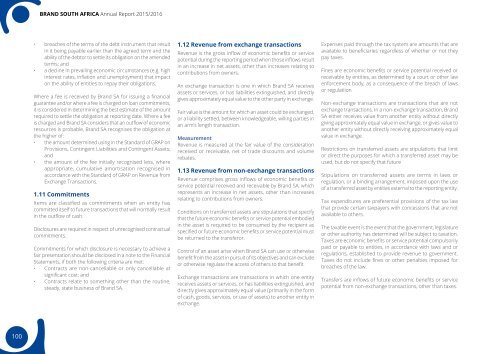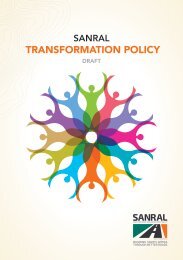Brand-South Africa - Annual report 2015 - 2016
During the past financial year, aligned with its mandate to build pride and patriotism in the Nation Brand, Brand South Africa has worked on initiatives to encourage active citizenship in partnership with its stakeholders in government, business, civil society and identified influential forums to increase the participation of all people, particularly our young people, in building a strong, cohesive Nation Brand. These activities, together with engagements at provincial level on Nation Brand alignment, contribute to social cohesion and a positive Nation Brand. Brand South Africa’s activities took place under the leadership of its new CEO, Amb. Kingsley Makhubela, PhD, who joined the organisation during the year.
During the past financial year, aligned with its mandate to build pride and patriotism in the Nation Brand, Brand South Africa has worked on initiatives to encourage active citizenship in partnership with its stakeholders in government, business, civil society and identified influential forums to increase the participation of all people, particularly our young people, in building a strong, cohesive Nation Brand. These activities, together with engagements at provincial level on Nation Brand alignment, contribute to social cohesion and a positive Nation Brand.
Brand South Africa’s activities took place under the leadership of its new CEO, Amb. Kingsley Makhubela, PhD, who joined the organisation during the year.
Create successful ePaper yourself
Turn your PDF publications into a flip-book with our unique Google optimized e-Paper software.
and south africa <strong>Annual</strong> Report <strong>2015</strong>/<strong>2016</strong><br />
• breaches of the terms of the debt instrument that result<br />
in it being payable earlier than the agreed term and the<br />
ability of the debtor to settle its obligation on the amended<br />
terms; and<br />
• a decline in prevailing economic circumstances (e.g. high<br />
interest rates, inflation and unemployment) that impact<br />
on the ability of entities to repay their obligations.<br />
Where a fee is received by <strong>Brand</strong> SA for issuing a financial<br />
guarantee and/or where a fee is charged on loan commitments,<br />
it is considered in determining the best estimate of the amount<br />
required to settle the obligation at <strong>report</strong>ing date. Where a fee<br />
is charged and <strong>Brand</strong> SA considers that an outflow of economic<br />
resources is probable, <strong>Brand</strong> SA recognises the obligation at<br />
the higher of:<br />
• the amount determined using in the Standard of GRAP on<br />
Provisions, Contingent Liabilities and Contingent Assets;<br />
and<br />
• the amount of the fee initially recognised less, where<br />
appropriate, cumulative amortisation recognised in<br />
accordance with the Standard of GRAP on Revenue from<br />
Exchange Transactions.<br />
1.11 Commitments<br />
Items are classified as commitments when an entity has<br />
committed itself to future transactions that will normally result<br />
in the outflow of cash.<br />
Disclosures are required in respect of unrecognised contractual<br />
commitments.<br />
Commitments for which disclosure is necessary to achieve a<br />
fair presentation should be disclosed in a note to the Financial<br />
Statements, if both the following criteria are met:<br />
• Contracts are non-cancellable or only cancellable at<br />
significant cost; and<br />
• Contracts relate to something other than the routine,<br />
steady, state business of <strong>Brand</strong> SA.<br />
1.12 Revenue from exchange transactions<br />
Revenue is the gross inflow of economic benefits or service<br />
potential during the <strong>report</strong>ing period when those inflows result<br />
in an increase in net assets, other than increases relating to<br />
contributions from owners.<br />
An exchange transaction is one in which <strong>Brand</strong> SA receives<br />
assets or services, or has liabilities extinguished, and directly<br />
gives approximately equal value to the other party in exchange.<br />
Fair value is the amount for which an asset could be exchanged,<br />
or a liability settled, between knowledgeable, willing parties in<br />
an arm’s length transaction.<br />
Measurement<br />
Revenue is measured at the fair value of the consideration<br />
received or receivable, net of trade discounts and volume<br />
rebates.<br />
1.13 Revenue from non-exchange transactions<br />
Revenue comprises gross inflows of economic benefits or<br />
service potential received and receivable by <strong>Brand</strong> SA, which<br />
represents an increase in net assets, other than increases<br />
relating to contributions from owners.<br />
Conditions on transferred assets are stipulations that specify<br />
that the future economic benefits or service potential embodied<br />
in the asset is required to be consumed by the recipient as<br />
specified or future economic benefits or service potential must<br />
be returned to the transferor.<br />
Control of an asset arise when <strong>Brand</strong> SA can use or otherwise<br />
benefit from the asset in pursuit of its objectives and can exclude<br />
or otherwise regulate the access of others to that benefit.<br />
Exchange transactions are transactions in which one entity<br />
receives assets or services, or has liabilities extinguished, and<br />
directly gives approximately equal value (primarily in the form<br />
of cash, goods, services, or use of assets) to another entity in<br />
exchange.<br />
Expenses paid through the tax system are amounts that are<br />
available to beneficiaries regardless of whether or not they<br />
pay taxes.<br />
Fines are economic benefits or service potential received or<br />
receivable by entities, as determined by a court or other law<br />
enforcement body, as a consequence of the breach of laws<br />
or regulatiion<br />
Non-exchange transactions are transactions that are not<br />
exchange transactions. In a non-exchange transaction, <strong>Brand</strong><br />
SA either receives value from another entity without directly<br />
giving approximately equal value in exchange, or gives value to<br />
another entity without directly receiving approximately equal<br />
value in exchange.<br />
Restrictions on transferred assets are stipulations that limit<br />
or direct the purposes for which a transferred asset may be<br />
used, but do not specify that future<br />
Stipulations on transferred assets are terms in laws or<br />
regulation, or a binding arrangement, imposed upon the use<br />
of a transferred asset by entities external to the <strong>report</strong>ing entity.<br />
Tax expenditures are preferential provisions of the tax law<br />
that provide certain taxpayers with concessions that are not<br />
available to others.<br />
The taxable event is the event that the government, legislature<br />
or other authority has determined will be subject to taxation.<br />
Taxes are economic benefits or service potential compulsorily<br />
paid or payable to entities, in accordance with laws and or<br />
regulations, established to provide revenue to government.<br />
Taxes do not include fines or other penalties imposed for<br />
breaches of the law.<br />
Transfers are inflows of future economic benefits or service<br />
potential from non-exchange transactions, other than taxes.<br />
100











